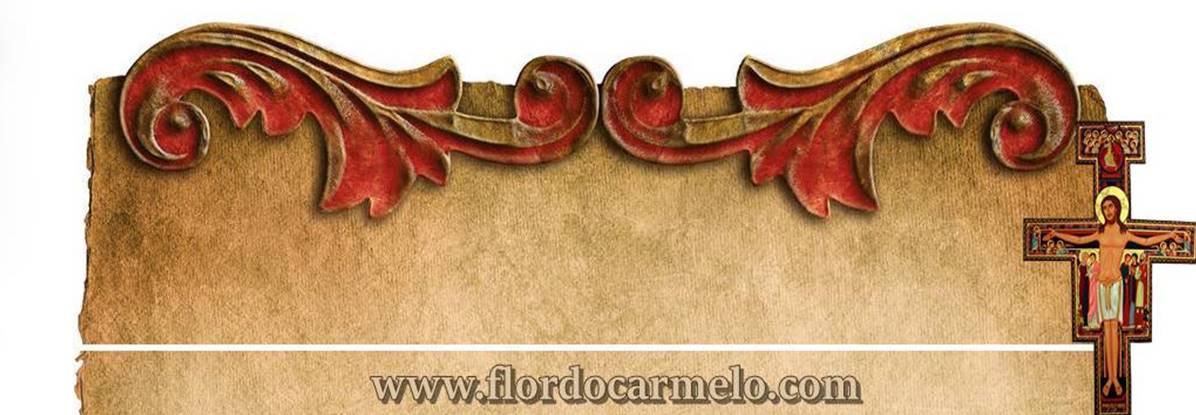The history of the brown scapular of Our Lady of Mount Carmel begins the mid-thirteenth century.
Back to begining of the Order in the Mount Carmel we see the hostilities faced by the Carmelites in Palestine, which forced them to move to Europe. The Carmelites remaining there drew courage to build a new monastery and church on the mountain. But these were to be of short duration, for finally in 1291, after the fall of Acre, the Saracens took Mount Carmel with fire and sword. It is related that the intrepid brothers courageously went to their martyrs' deaths, singing the Salve Regina. They must have thanked God, as they were put to the sword, that the eternal spirit of Carmel now lived and flourished in other lands across the sea.
As early as the year 1219, Saint Angelus, called by an early writer "the glorious martyr," had introduced the Carmelite life into Sicily. Soon others had carried it to Cyprus, to France, and to Flanders. By the year 1237 when the first general chapter was held on the mountain, the emigration of friars to Europe was well under way. But many there were who vowed they would never willingly leave the Holy Mountain except under obedience.
The strictly contemplative life of the desert hermits of Carmel. Francis and Dominic, during the sunset of feudalism, and the concentration of populations in the cities, had changed all that. The Franciscans and the Dominicans lived among the people, preaching and teaching, working among the poor and establishing themselves at the universities. Traditional descendants of the early hermits of the desert were hard put to it to find any deserts in Europe. The older contemplative Orders were increasingly leaving their feudal solitudes to work among the people. The Carmelites, devoted to silence and contemplation, had not been able to carry their Holy Mountain with them; and now perforce must adopt a different type of monastic life. But although they wisely modified their program to meet Western needs, they were still to retain the marked characteristics of contemplatives, and to follow a Rule, which exceeded in austerity that of other Orders which had preceded them in Europe.
Saint Simon Stock
There had arisen in England a holy Carmelite of great vision and ability, Simon Stock, who saw quite clearly the new path which the Order must take to survive. In 1245 a general Chapter was called at Aylesford to discuss modifications of the Rule, at which he was elected Father General of the transplanted Order. It was determined that the Carmelites should become a mendicant Order, as were the Franciscans and Dominicans; and that the hermits should be transformed into friars, to undertake their share of aiding the diocesan clergy in their ministry among the people. In the new mode of life it would be necessary to mitigate some of the former austerities as they had been practised on Mount Carmel, for they were now engaged upon an active apostolate. They retained however many of their eremitical customs, including long hours of meditation in their cells.
Within a short time, the new General had won the approval of Pope Innocent IV for the modified Rule. Now the Carmelites began to spread rapidly throughout England and into Ireland and Scotland, France and Germany, Spain and Italy. Within a period of thirteen years, foundations had been made at Cambridge, Oxford, London, York, Paris, Bologna, and Naples. Simon Stock was anxious to establish the Carmelites at the universities, since now the new work of the Order demanded both preachers and teachers.
While amazingly successful in effecting these transitions from the old way to the new, yet was his path far from easy. The Order was competing with the sons of Francis and Dominic who had been established in Europe some fifty years before the Carmelites, and who were bound by a less austere observance. And he was meeting opposition from the Bishops and the diocesan clergy everywhere who questioned the canonical status of his Order. The Church's Council of Lateran in 1215 had forbidden the further establishment of new Orders, but the Carmelites could point back to years preceding that date when they had functioned in the Holy Land as an Order formally approved by the Apostolic Legate, the Patriarch Albert of Jerusalem. Nevertheless, during the General's long life — it is said that he died at the age of one hundred — the matter remained a subject of contention.
It is concerning his anxiety about recognition of the Order that tradition associates the famous vision of the Blessed Virgin accorded him at Cambridge (though more probably at Aylesford) in 1251, when he saw her as she held the Carmelite scapular in her hands and assured him that all who would die wearing it would be saved from eternal punishment. From this tradition sprang the scapular devotion approved by the Church, which the laity through the centuries and up to the present have faithfully followed in prayer, themselves wearing the Carmelite scapular in miniature.
To be continued...


No comments:
Post a Comment